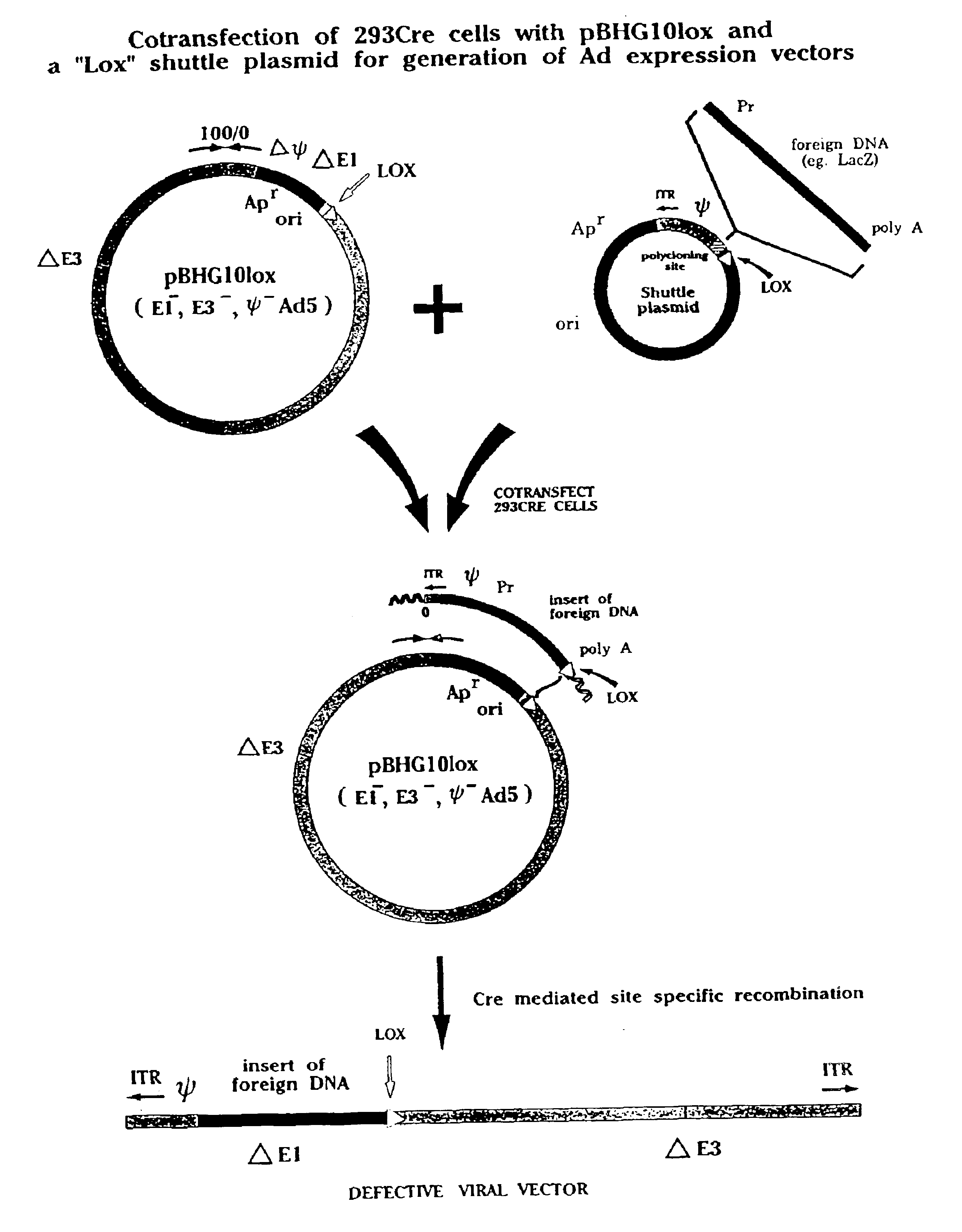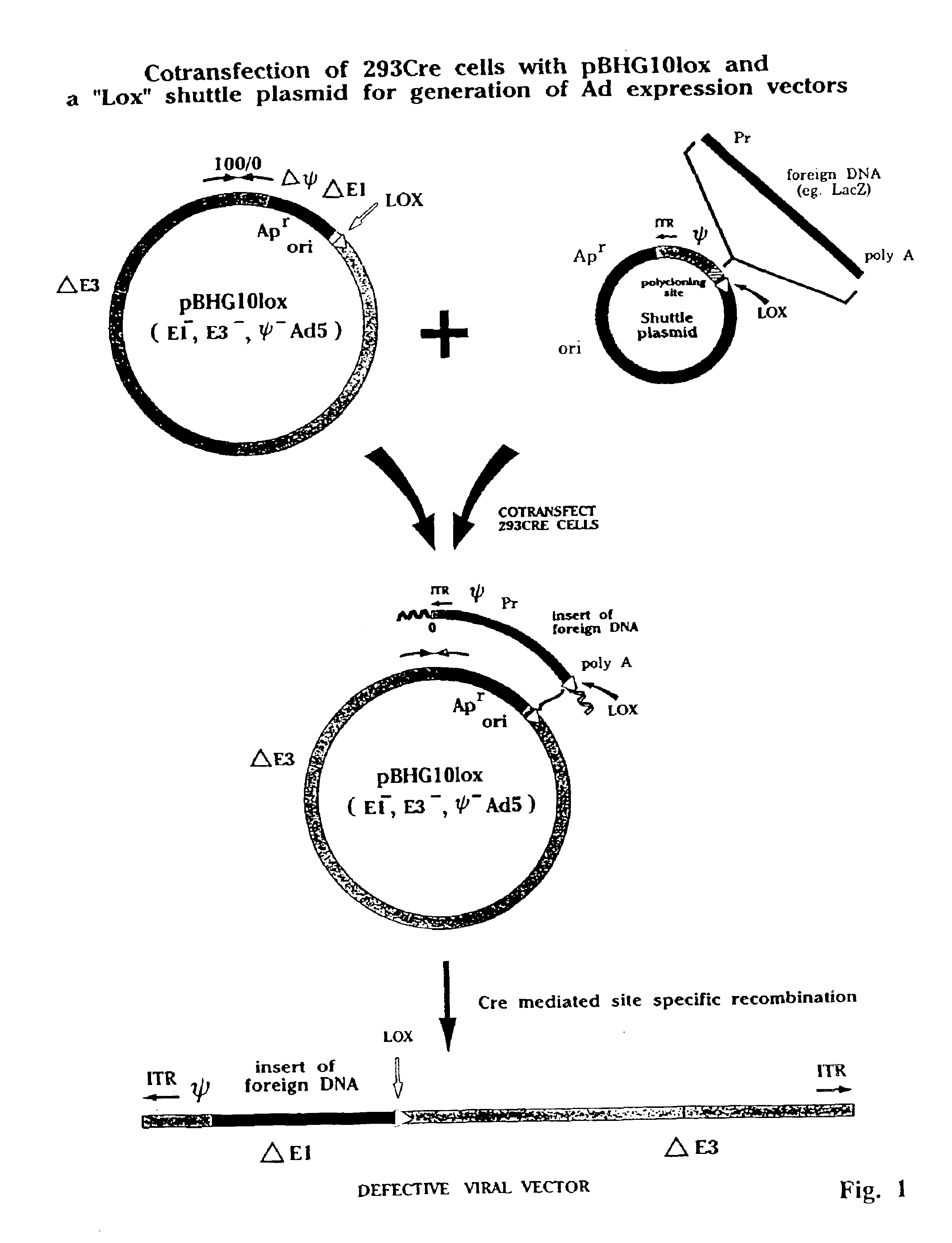Enhanced system for construction of adenovirus vectors
- Summary
- Abstract
- Description
- Claims
- Application Information
AI Technical Summary
Benefits of technology
Problems solved by technology
Method used
Image
Examples
example 1
Two-Plasmid Site-Specific Adenoviral Recombination
[0093]FIG. 1 provides a graphic representation of the use of a plasmid, pBHGloxΔE1,3, which comprises a circularized form of the Ad genome in which part or all of the E1 region, including the packaging signal, is substituted by sequences comprising a bacterial plasmid origin of replication and an antibiotic resistance gene, such as that encoding ampicillin resistance. The plasmid further comprises a loxP site near the 5′ end of the pIX gene of the Ad genome. The plasmid may also, optionally, have a deletion of E3 sequences (as shown in this illustration by the symbol ΔE3) which may optionally be substituted with one or more unique cloning sites for insertion of foreign DNA in the ΔE3 region.
[0094]A second component of the invention comprises a “shuttle plasmid” containing an ITR of the virus genome and a packaging signal, a polycloning site into which may be inserted a foreign DNA such as that encoding for bacterial β-galactosidase (...
example 2
Comparison of Homologous and Site-Specific Recombination
[0096]FIG. 2A illustrates use of a modified shuttle plasmid wherein Ad sequences from about 10 mu to about 15 mu are present to the right of the lox site. These sequences permit homologous recombination to occur in the absence or presence of Cre. A shuttle plasmid such as that shown in this figure is generally used only for comparison purposes to assess the relative efficiency of homologous versus Cre-mediate recombination. As will be seen in the subsequent description of the invention, in the presence of Cre, overlapping sequences are unnecessary and can be omitted, although this disclosure does not require the absence of such sequences.
example 3
Sequences Useful in the Production of Plasmids which may be Recombined in a Site-Specific Manner to Produce Adenoviral Vectors
[0097]FIG. 3 illustrates sets of oligonucleotides used in various cloning procedures. The double stranded oligonucleotide (SEQ ID NO:1 and SEQ ID NO:2; AB3233 / 3234) contains a loxP site with restriction sites for ScaI and EcoRI at one end of the oligo outside of the loxP region. When annealed, the oligonucleotides have BamHI / BglII overhangs which are designed for cloning into and concomitant destruction of the BglII site. The internal ScaI site found in SEQ ID NO:1 and SEQ ID NO:2 (AB3233 / 3234) was designed to facilitate determination of the orientation of the linker and also for subsequent deletion of Ad5 sequences from m.u. 9.8-15.8. The second linker (SEQ ID NO:3 and SEQ ID NO:4; AB14626 / 14627) has EcoRI and SalI overhangs and a multiple cloning region containing SmaI, BglII, HindIII and ScaI restriction sites.
PUM
| Property | Measurement | Unit |
|---|---|---|
| Length | aaaaa | aaaaa |
| Length | aaaaa | aaaaa |
| Mass | aaaaa | aaaaa |
Abstract
Description
Claims
Application Information
 Login to View More
Login to View More - R&D
- Intellectual Property
- Life Sciences
- Materials
- Tech Scout
- Unparalleled Data Quality
- Higher Quality Content
- 60% Fewer Hallucinations
Browse by: Latest US Patents, China's latest patents, Technical Efficacy Thesaurus, Application Domain, Technology Topic, Popular Technical Reports.
© 2025 PatSnap. All rights reserved.Legal|Privacy policy|Modern Slavery Act Transparency Statement|Sitemap|About US| Contact US: help@patsnap.com



